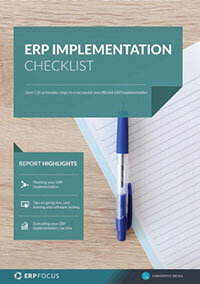The case for multi-tier ERP implementations
Big companies often feel most comfortable implementing Tier 1 ERP systems, while most smaller organizations (though they may admire the enterprises that can spend tens or even hundreds of millions on such systems) are pragmatic enough to recognize that Tier 3 ERP solutions are a more realistic fit for their size and needs.
In the middle are Tier 2 ERP systems, typically used by mid-sized businesses or independent divisions within large conglomerates.
This article examines the pros and cons of both the single-tier ERP approach and the multi-tier ERP approach, since, as with most things in enterprise software, there’s no one-size-fits-all solution.
To some extent, this is already happening. Some large organizations use, for example, SAP ECC (a Tier 1 system) alongside SAP Business One (a Tier 3 ERP). Likewise, some mid-sized firms deploy Sage Enterprise Management (a Tier 2 ERP) in parallel with Sage 200 (a Tier 3).
Many companies initially assume the smaller system is simply a scaled-down version of the larger one. They expect running both side by side will be straightforward. However, that’s rarely the case. Even when two ERP systems come from the same vendor, they can have entirely different architectures and very little in common.
The advantages of a single tier 1 system
Cost is frequently given as a justification for standardizing one system. At first glance, it may seem logical that adding extra licenses for a Tier 1 ERP is cheaper than buying separate Tier 2 or Tier 3 systems. Yet with vendors like SAP now pricing based on transaction volumes, companies would be wise to check.
Standardizing can reduce training costs, especially when rolling out in phases. Implementation teams from the first company can support subsequent rollouts, sharing experience and best practices. This collaboration speeds up deployment and reduces reliance on expensive consultants.
A further advantage: some organizations retain part of their ERP project team after go-live to form an internal support group. This team provides first-line assistance, evaluates new releases, and manages updates and training. Over time, this approach can reduce the total cost of ownership while helping the organization extract maximum value from its chosen ERP tier.
Potential drawbacks of a single-tier ERP
Cost advantages can be less predictable than expected. Many systems are priced by concurrent users or modules, meaning a small business unit may pay for functionality it doesn’t need. For example, a small manufacturing division may need only basic materials planning but still pay for full MRP access, or be forced to use complex pricing tools irrelevant to their workflow.
Simplifying a large, complex system for smaller teams is difficult. It’s not just about disabling unused modules; it often requires redesigning processes and workarounds, which often ends up being a clunky system that frustrates users (many end up relying on spreadsheets to fill functionality gaps).
Why consider a multi-tier ERP strategy?
Because a “one system fits all” model doesn’t always work, many organizations explore multi-tier ERP implementations. This approach is more flexible, but it isn't without its own challenges.
Of course, managing multiple implementations is trickier. Tier 1 ERP projects can take several years, while Tier 3 systems might be live within months. Smaller subsidiaries may be ready to go long before the enterprise rollout is finished, and asking them to wait can cause frustration.
While total costs are harder to pin down, selecting two or three systems won’t necessarily double your budget. Shared planning and requirements can reduce overlap. A sensible way forward is to let different parts of the group move at their own pace (within a clear overall strategy).
Bringing the data together
Even with multiple ERP tiers, most groups still want consolidated financial reporting. That can be done by integrating data into a central accounting platform or by using the financial modules of a Tier 1 or Tier 2 ERP.
The key is clean, reliable data transfer. A shared chart of accounts and defined integration routines make it easier to keep everything aligned. The good news is that modern integration tools don’t need to sync every single transaction—they can roll data up efficiently for reporting.
However, if some companies go live before others, temporary links to legacy systems may be needed, adding another round of work later.
Different systems can also make it harder to share user experiences or align day-to-day processes. Still, those differences often come down to company size and structure, not the ERP itself.
Choosing the right fit for each business
Again, the main advantage of multi-tier ERP is flexibility. Tier 3 ERPs are typically a better fit for smaller organizations, as they are quicker to implement, easier to maintain, and less expensive overall.
Consultants for Tier 3 and Tier 2 systems also tend to be more affordable than Tier 1 specialists. They also focus on tailoring the system rather than cutting down unneeded features. That helps smaller teams feel ownership and confidence in the tools they use.
Meanwhile, larger entities can still adopt a comprehensive Tier 1 system suited to complex global operations without being held back by smaller sites with simpler needs.
Final thoughts
The choice between a single-tier and multi-tier ERP depends on how similar or different your business units are.
If each division is roughly the same size and operates in similar ways, one Tier 1 system might make sense. But if your group includes a mix of large, medium, and small operations, integrating ERPs from tiers 1-3 can be more practical and cost-effective.
The more diverse your operations, the stronger the case for a multi-tier model. The encouraging part is that modern ERP software and integration tools make that approach more achievable than ever.
Free white paper

ERP Implementation Checklist
Over 120 actionable steps to implementing a new ERP successfully

Featured white papers
-

ERP Implementation: 9 steps to success
The 9 proven steps you should follow when implementing ERP
Download -

ERP Implementation Checklist
Over 120 actionable steps to implementing a new ERP successfully
Download -

Manufacturing ERP Implementation Checklist
Over 70 actionable steps to rolling out new manufacturing ERP software
Download
Related articles
-

An example ERP implementation team structure for your project
Learn about three key elements of an ERP implementation team and the individuals who contribute w...
-

Secret KPI: Why Your ERP Implementation Team Matters More Than Software
Learn how Godlan ensures successful ERP implementation for manufacturers with proven strategies &...
-

Change management for ERP implementation: a case study
A real-world example of the benefits of weaving change management into the fabric of an ERP imple...

